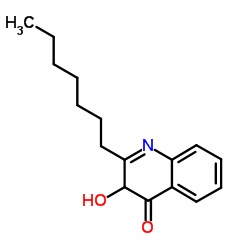The Pseudomonas aeruginosa 4-quinolone signal molecules HHQ and PQS play multifunctional roles in quorum sensing and iron entrapment.
Stephen P Diggle, Sandra Matthijs, Victoria J Wright, Matthew P Fletcher, Siri Ram Chhabra, Iain L Lamont, Xiaole Kong, Robert C Hider, Pierre Cornelis, Miguel Cámara, Paul Williams
Index: Chem. Biol. 14 , 87-96, (2007)
Full Text: HTML
Abstract
Pseudomonas aeruginosa produces 2-heptyl-3-hydroxy-4(1H)-quinolone (PQS), a quorum-sensing (QS) signal that regulates numerous virulence genes including those involved in iron scavenging. Biophysical analysis revealed that 2-alkyl-3-hydroxy-4-quinolones form complexes with iron(III) at physiological pH. The overall stability constant of 2-methyl-3-hydroxy-4-quinolone iron(III) complex was log beta(3) = 36.2 with a pFe(3+) value of 16.6 at pH 7.4. PQS was found to operate via at least three distinct signaling pathways, and its precursor, 2-heptyl-4-quinolone (HHQ), which does not form an iron complex, was discovered to function as an autoinducer molecule per se. When PQS was supplied to a P. aeruginosa mutant unable to make pyoverdine or pyochelin, PQS associated with the cell envelope and inhibited bacterial growth, a finding that reveals a secondary function for PQS in iron entrapment to facilitate siderophore-mediated iron delivery.
Related Compounds
| Structure | Name/CAS No. | Molecular Formula | Articles |
|---|---|---|---|
 |
2-Heptyl-3-hydroxy-4(1H)-quinolinone
CAS:108985-27-9 |
C16H21NO2 |
|
Quinolone signaling in the cell-to-cell communication system...
1999-09-28 [Proc. Natl. Acad. Sci. U. S. A. 20th ed., 96 , 11229-11234, (1999)] |
|
3-indolylacetonitrile decreases Escherichia coli O157:H7 bio...
2011-01-01 [Environ. Microbiol. 13 , 62-73, (2011)] |
|
Differential immune modulatory activity of Pseudomonas aerug...
2004-11-01 [Infect. Immun. 72(11) , 6463-6470, (2004)] |
|
Indole and 7-hydroxyindole diminish Pseudomonas aeruginosa v...
2009-01-01 [Microb. Biotechnol. 2 , 75-90, (2009)] |
|
7-fluoroindole as an antivirulence compound against Pseudomo...
2012-04-01 [FEMS Microbiol. Lett. 329 , 36-44, (2012)] |